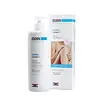What's inside
What's inside
 Key Ingredients
Key Ingredients

 Benefits
Benefits

 Concerns
Concerns

 Ingredients Side-by-side
Ingredients Side-by-side

Water
Skin ConditioningUrea
BufferingEthylhexyl Stearate
EmollientCaprylic/Capric Triglyceride
MaskingGlycerin
HumectantButyrospermum Parkii Butter
Skin ConditioningCyclopentasiloxane
EmollientC12-15 Alkyl Benzoate
AntimicrobialPolyglyceryl-6 Distearate
EmulsifyingSodium Citrate
BufferingSodium Acrylate/Sodium Acryloyldimethyl Taurate Copolymer
Emulsion StabilisingCetearyl Alcohol
EmollientDimethicone
EmollientJojoba Esters
EmollientNiacinamide
SmoothingCandelilla/Jojoba/Rice Bran Polyglyceryl-3 Esters
EmulsifyingC15-19 Alkane
SolventPhenoxyethanol
PreservativePotassium Cetyl Phosphate
EmulsifyingCitric Acid
BufferingLauryl Glucoside
CleansingEthylhexylglycerin
Skin ConditioningTetrasodium Glutamate Diacetate
Tocopherol
AntioxidantWater, Urea, Ethylhexyl Stearate, Caprylic/Capric Triglyceride, Glycerin, Butyrospermum Parkii Butter, Cyclopentasiloxane, C12-15 Alkyl Benzoate, Polyglyceryl-6 Distearate, Sodium Citrate, Sodium Acrylate/Sodium Acryloyldimethyl Taurate Copolymer, Cetearyl Alcohol, Dimethicone, Jojoba Esters, Niacinamide, Candelilla/Jojoba/Rice Bran Polyglyceryl-3 Esters, C15-19 Alkane, Phenoxyethanol, Potassium Cetyl Phosphate, Citric Acid, Lauryl Glucoside, Ethylhexylglycerin, Tetrasodium Glutamate Diacetate, Tocopherol
Water
Skin ConditioningUrea
BufferingCetearyl Ethylhexanoate
EmollientPanthenol
Skin ConditioningGlyceryl Stearate
EmollientPEG-40 Stearate
EmulsifyingGlycerin
HumectantDimethicone
EmollientPersea Gratissima Oil
Skin ConditioningShorea Stenoptera Seed Butter
EmollientPhenoxyethanol
PreservativeCetyl Alcohol
EmollientOctyldodecanol
EmollientCarbomer
Emulsion StabilisingPalmitic Acid
EmollientStearic Acid
CleansingDisodium EDTA
Ethylhexylglycerin
Skin ConditioningParfum
MaskingSodium Hydroxide
BufferingBHT
AntioxidantLactic Acid
BufferingLimonene
PerfumingHexyl Cinnamal
PerfumingAlpha-Isomethyl Ionone
PerfumingLinalool
PerfumingBenzyl Salicylate
PerfumingEugenol
PerfumingCitral
PerfumingHydroxycitronellal
PerfumingCoumarin
PerfumingWater, Urea, Cetearyl Ethylhexanoate, Panthenol, Glyceryl Stearate, PEG-40 Stearate, Glycerin, Dimethicone, Persea Gratissima Oil, Shorea Stenoptera Seed Butter, Phenoxyethanol, Cetyl Alcohol, Octyldodecanol, Carbomer, Palmitic Acid, Stearic Acid, Disodium EDTA, Ethylhexylglycerin, Parfum, Sodium Hydroxide, BHT, Lactic Acid, Limonene, Hexyl Cinnamal, Alpha-Isomethyl Ionone, Linalool, Benzyl Salicylate, Eugenol, Citral, Hydroxycitronellal, Coumarin
 Reviews
Reviews

Ingredients Explained
These ingredients are found in both products.
Ingredients higher up in an ingredient list are typically present in a larger amount.
Dimethicone is a type of synthetic silicone created from natural materials such as quartz.
What it does:
Dimethicone comes in different viscosities:
Depending on the viscosity, dimethicone has different properties.
Ingredients lists don't always show which type is used, so we recommend reaching out to the brand if you have questions about the viscosity.
This ingredient is unlikely to cause irritation because it does not get absorbed into skin. However, people with silicone allergies should be careful about using this ingredient.
Note: Dimethicone may contribute to pilling. This is because it is not oil or water soluble, so pilling may occur when layered with products. When mixed with heavy oils in a formula, the outcome is also quite greasy.
Learn more about DimethiconeEthylhexylglycerin (we can't pronounce this either) is commonly used as a preservative and skin softener. It is derived from glyceryl.
You might see Ethylhexylglycerin often paired with other preservatives such as phenoxyethanol. Ethylhexylglycerin has been found to increase the effectiveness of these other preservatives.
Glycerin is already naturally found in your skin. It helps moisturize and protect your skin.
A study from 2016 found glycerin to be more effective as a humectant than AHAs and hyaluronic acid.
As a humectant, it helps the skin stay hydrated by pulling moisture to your skin. The low molecular weight of glycerin allows it to pull moisture into the deeper layers of your skin.
Hydrated skin improves your skin barrier; Your skin barrier helps protect against irritants and bacteria.
Glycerin has also been found to have antimicrobial and antiviral properties. Due to these properties, glycerin is often used in wound and burn treatments.
In cosmetics, glycerin is usually derived from plants such as soybean or palm. However, it can also be sourced from animals, such as tallow or animal fat.
This ingredient is organic, colorless, odorless, and non-toxic.
Glycerin is the name for this ingredient in American English. British English uses Glycerol/Glycerine.
Learn more about GlycerinPhenoxyethanol is a preservative that has germicide, antimicrobial, and aromatic properties. Studies show that phenoxyethanol can prevent microbial growth. By itself, it has a scent that is similar to that of a rose.
It's often used in formulations along with Caprylyl Glycol to preserve the shelf life of products.
Urea is also called carbamide and is the diamide of carbonic acid. In cosmetics, urea is used to hydrate the skin. It also provides exfoliation in higher concentrations.
As a humectant, urea helps draw moisture from the air and from deep within the skin. This helps hydrate your skin. Studies show urea is an effective moisturizer for dry skin conditions. 40% urea is typical in medications for treating eczema and other skin conditions.
Urea has the strongest exfoliation effect in concentrations higher than 10%. It is a keratolytic agent, meaning it breaks down the keratin protein in the top layer of skin. This helps remove dead skin cells and flaking skin.
In medicine, urea has been shown to help increase the potency of other ingredients, such as fungal treatments.
Humans and animals use urea to metabolize nitrogen-containing compounds. Urea is highly soluble in water. Once dissolved, it is neither acidic nor alkaline.
Learn more about UreaWater. It's the most common cosmetic ingredient of all. You'll usually see it at the top of ingredient lists, meaning that it makes up the largest part of the product.
So why is it so popular? Water most often acts as a solvent - this means that it helps dissolve other ingredients into the formulation.
You'll also recognize water as that liquid we all need to stay alive. If you see this, drink a glass of water. Stay hydrated!
Learn more about Water